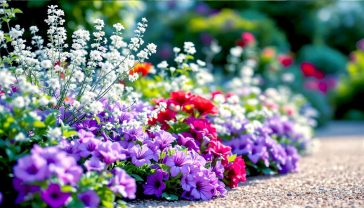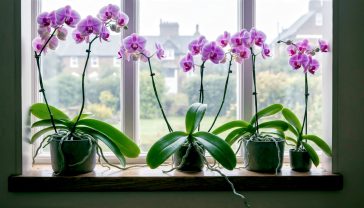Edible Flowers: Adding a Bloom to Your Dishes
Your complete guide to edible flowers. Learn the history, how to identify safe blooms like nasturtiums and roses, and find recipes for stunning floral dishes.

This post may contain affiliate links. If you make a purchase through these links, we may earn a commission at no additional cost to you.
There’s a quiet magic to scattering a handful of bright petals over a salad or placing a single, crystallised violet on a dessert. It feels a bit daring, a bit special. For many of us, flowers are for looking at, for filling vases, or for planting in the garden to cheer up a grey British afternoon. The idea of actually eating them can seem strange, a modern fad for fancy restaurants. But here’s a secret: we’ve been eating flowers for thousands of years. It’s one of cooking’s oldest and most beautiful tricks.
From the Romans who tossed violets and roses into their food to the Tudors who loved a colourful ‘sallet’ full of primroses and marigolds, flowers have long been part of our plates. They were the original seasonings, colourings, and garnishes, picked straight from the garden long before supermarkets existed. Today, that tradition is blooming once again. Chefs, bakers, and home cooks are rediscovering the joy that edible flowers can bring to a dish. They can add a peppery kick, a hint of cucumber, or a sweet perfume, not to mention turning a simple cake into a work of art.
This guide is your complete journey into the world of edible flowers. We’ll dig into their surprising history, learn how to tell the friendly flowers from the dangerous ones, and cover everything you need to know about growing, harvesting, and preparing them. By the end, you’ll be ready to bring a little bit of garden magic into your own kitchen.
A Blooming History: The Long and Surprising Story of Eating Flowers
Eating flowers isn’t a new trend you’ve seen on Instagram. It’s an ancient practice that has woven its way through cultures and centuries, including right here in Britain.
Ancient Roots and Roman Feasts
The story starts a very long time ago. The ancient Chinese were using flowers in their cooking thousands of years ago, while in the Roman Empire, no fancy feast was complete without them. Romans were particularly fond of roses and violets. They would make rose-flavoured puddings and wines and use violet petals to garnish dishes and flavour sauces. It was all about showing off wealth and taste, and what could be more luxurious than eating beautiful flowers?
Medieval and Tudor Kitchen Gardens
Fast forward to Medieval Britain, and flowers were a staple in the kitchen. With limited access to exotic spices, people used what grew around them. Flowers from the garden were a source of both flavour and medicine. A popular ingredient was the bright orange pot marigold (Calendula officinalis). Its petals were often called ‘poor man’s saffron’ because they gave food a lovely golden colour without the eye-watering cost of real saffron. They were chucked into soups, stews (or ‘pottages’), and rice dishes.
In the Tudor and Stuart periods, salads—or ‘sallets’ as they were known—were incredibly popular and often full of flowers. People would eat the young leaves and flowers of primroses, cowslips, and violets. These weren’t just for looks; they added different textures and tastes to the bowl.
The Victorian Language of Flowers
The Victorian era was the golden age of flowers. The Victorians were obsessed with them, even developing a ‘language of flowers’ called floriography, where every bloom had a secret meaning. This love affair naturally spilled over into the kitchen.
One of the most famous Victorian floral treats was crystallised or candied flowers. Violets, primroses, and rose petals were delicately painted with egg white and dusted with caster sugar, preserving them as delicate, edible decorations. You could find them on top of elegant trifles, jellies, and cakes. Flavourings like rosewater and orange blossom water also became incredibly popular in sweets, biscuits, and cordials. For the Victorians, eating flowers was a symbol of elegance and refinement.
The 20th-Century Dip and Modern Revival
Strangely, as the 20th century rolled on, cooking with flowers fell out of fashion. It was seen as fussy and old-fashioned. Two world wars meant food was about function, not beauty, and the rise of processed food in the following decades pushed garden-to-table cooking to the side.
But in the last 20 years or so, we’ve seen a huge comeback. Celebrity chefs like Jamie Oliver and Nigella Lawson started using them, reminding us how beautiful they can make a dish look. The farm-to-table movement encouraged people to think more about where their food comes from, and what could be more local than your own garden? And of course, social media played a huge part. A dish decorated with vibrant flowers is incredibly ‘Instagrammable’, and soon everyone wanted to try it. Today, you can even buy punnets of edible flowers in supermarkets, bringing this ancient tradition firmly into the 21st century.
The Edible Flower Patch: A Gardener’s Guide to Safe and Tasty Blooms
This is the most important part of your journey into eating flowers. While many flowers are delicious, many others are poisonous. You absolutely must be sure about what you are picking.
The Golden Rules of Foraging for Flowers
Before you even think about nibbling on a petal, you need to learn the rules. Getting this wrong can make you very ill.
- If in Doubt, Leave It Out. This is the number one rule. If you are not 100% certain that you have correctly identified a flower, do not eat it. It is not worth the risk. Use a reliable plant identification guide or app, and if possible, learn from someone experienced.
- Know the Enemy. Many common British garden plants are toxic. This includes beautiful flowers like foxgloves, daffodils, lupins, rhododendrons, oleander, lily-of-the-valley, and the flowers of the sweet pea (the edible pea flowers are from a different plant). Never assume a flower is edible just because it looks pretty.
- Use Scientific Names. Common names for plants can be confusing and vary from place to place. For example, some people call Calendula ‘marigold’, but the French Marigold (Tagetes) is a different plant entirely. Using the Latin scientific name helps you know exactly what you’re dealing with.
- Avoid Sprays and Pollution. Only eat flowers that you know are free from pesticides and chemicals. This means either growing them yourself organically or buying them from a trusted source that sells them specifically for eating. Never, ever eat flowers from a florist, garden centre, or roadside. They are often treated with chemicals that are not safe for consumption.
A Serious Warning: Never guess. Misidentifying a plant can have severe consequences. Some poisonous plants can look similar to edible ones. Always be 100% certain before eating any flower.
Your A-Z of Edible Flowers for British Gardens
Here is a list of some of the most popular and easiest-to-identify edible flowers that you can grow in the UK.
Flowers from the Herb & Veg Patch
- Borage (Borago officinalis)
- Appearance: Beautiful, star-shaped blue flowers that bees absolutely love.
- Taste: A wonderfully refreshing, cool taste of cucumber.
- How to Use: The perfect garnish for a summer G&T or a glass of Pimm’s. Freeze them in ice cubes for a pretty touch. Toss them into salads or sprinkle them over soups.
- Growing Tips: Incredibly easy to grow from seed in spring. It self-seeds enthusiastically, so you’ll likely have it forever once you plant it.
- Chive Flowers (Allium schoenoprasum)
- Appearance: Fluffy, purple pom-pom flowers that appear in late spring.
- Taste: A mild, delicate onion flavour, just like the leaves.
- How to Use: Break the flower heads into individual florets and sprinkle them over salads, scrambled eggs, or potato salad. They look amazing and add a gentle oniony bite. You can also infuse them in vinegar.
- Growing Tips: Chives are hardy perennials. Just let a clump go to flower instead of trimming them all back.
- Courgette (Zucchini) Flowers (Cucurbita pepo)
- Appearance: Large, vibrant yellow-orange trumpet-shaped flowers.
- Taste: Very delicate, with a slight courgette flavour.
- How to Use: A true delicacy. The most famous way to cook them is to stuff them with ricotta cheese and herbs, dip them in a light batter, and fry them until golden. You can also chop them up and add them to omelettes or pasta dishes.
- Growing Tips: Pick the male flowers (the ones on a thin stem) in the morning when they are open, leaving a few to pollinate the female flowers (the ones with a tiny courgette at their base).
- Nasturtium (Tropaeolum majus)
- Appearance: Bright, cheerful flowers in shades of yellow, orange, and red. Both the flowers and the round leaves are edible.
- Taste: Wonderfully peppery, a bit like rocket or watercress. The colour often hints at the intensity—the darker reds can be spicier.
- How to Use: A brilliant addition to salads, adding both colour and a zesty kick. The entire flower can be used. You can also stuff the flowers or use the leaves in place of rocket in a pesto. The unopened flower buds can be pickled to make ‘poor man’s capers’.
- Growing Tips: Very easy to grow from seed. They thrive on neglect and poor soil and will happily trail out of pots or climb up a trellis.
- Lavender (Lavandula angustifolia)
- Appearance: Spikes of tiny, fragrant purple flowers.
- Taste: Highly perfumed, floral, and slightly sweet. A little goes a very long way!
- How to Use: Use it sparingly. It’s most famous in baking. Try adding a tiny amount of chopped flowers to shortbread recipes, scones, or cakes. You can also infuse sugar with lavender flowers to use in desserts or drinks.
- Growing Tips: Make sure you use English Lavender (Lavandula angustifolia), as it has the best flavour for cooking. It loves a sunny, well-drained spot.
Classic Garden Flowers
- Rose (Rosa)
- Appearance: One of the most famous flowers in the world. All varieties are edible.
- Taste: The flavour varies depending on the type and colour, ranging from fruity and apple-like to more perfumed and floral. Generally, the more fragrant the rose, the more flavourful the petals.
- How to Use: Remove the white base of the petals as it can be bitter. Use fresh petals in salads, freeze them in ice cubes, or sprinkle them over desserts. They can be used to make rosewater, syrups, jellies, and jams. Crystallised rose petals are a classic cake decoration.
- Growing Tips: Choose a fragrant, old-fashioned variety of rose for the best flavour.
- Pansies & Violas (Viola x wittrockiana & Viola tricolor)
- Appearance: Sweet, delicate flowers with ‘faces’, coming in a huge range of colours.
- Taste: Mild and slightly sweet, with a grassy, lettuce-like flavour.
- How to Use: They are mostly used for their looks. They are perfect for pressing into the icing of cakes and biscuits, decorating salads, or freezing into ice cubes. They can be crystallised just like violets.
- Growing Tips: Easy to grow in pots or borders. They prefer cooler weather, so they are great for spring and autumn colour.
- Calendula / Pot Marigold (Calendula officinalis)
- Appearance: Bright orange and yellow daisy-like flowers. Not to be confused with French Marigolds (Tagetes), which are not recommended for eating.
- Taste: The petals are slightly peppery and tangy.
- How to Use: As mentioned, they were known as ‘poor man’s saffron’. Pluck the petals from the flower head and sprinkle them into rice, soups, or salads to add a beautiful golden colour. You can also mix them into softened butter.
- Growing Tips: Dead easy to grow from seed. They flower for months on end if you keep deadheading them.
- Cornflower (Centaurea cyanus)
- Appearance: Stunning, intense blue flowers (though they also come in pink, white, and purple).
- Taste: A mild, slightly sweet and spicy flavour, a bit like cloves.
- How to Use: Mainly used for their incredible colour. The blue petals look amazing sprinkled over salads, omelettes, or as a garnish on cakes. They are often included in a dried edible flower mix and in Lady Grey tea.
- Growing Tips: A classic wildflower that’s easy to grow from seed in a sunny spot.
- Elderflower (Sambucus nigra)
- Appearance: Large, flat-topped clusters of tiny, creamy-white, fragrant flowers found on elder trees in late spring.
- Taste: A unique, delicate, and fragrant floral taste.
- How to Use: Famous for making the classic British summer drink: Elderflower Cordial. The flower heads can also be dipped in batter and fried to make elderflower fritters.
- Growing Tips: Forage for them in hedgerows and woodlands in May and June. Make sure to correctly identify the elder tree and avoid picking from polluted areas. Only use the flowers—the leaves and stems are toxic.
From Garden to Plate: How to Harvest, Prepare, and Store Your Blooms
Once you’ve safely identified your flowers, you need to know how to handle them correctly to get them ready for the kitchen.
Harvesting with Care
Timing and technique are everything when it comes to picking flowers for eating.
- When to Pick: The best time is in the cool of the morning, just after the dew has evaporated. The flowers will be at their freshest and most flavourful. Picking in the heat of the day can cause them to wilt quickly.
- What to Pick: Choose flowers that are fully open and look vibrant. Avoid any that are starting to fade, look wilted, or are still in bud. Give them a gentle shake before you pick them to dislodge any resident insects.
Cleaning and Preparation
Flowers are delicate, so they need a gentle touch.
- Inspect for Bugs: First, give your flowers a good look-over. Small insects love to hide in the petals. A gentle shake will usually encourage them to leave.
- A Quick Rinse: If they need cleaning, give them a very brief dip in a bowl of cold water. Don’t hold them under a running tap as it can damage the petals.
- Dry Gently: Carefully lift the flowers out of the water and lay them on a paper towel or a clean tea towel to air dry. Patting them can bruise the delicate petals.
- Prepare the Petals: For most flowers, it’s just the petals you want to eat. The base of the flower (the calyx), the stamens (which hold the pollen), and the pistil can often be bitter.
- For flowers like roses, calendulas, and tulips, gently pull the petals from the base. You might want to snip off the small white bit at the very bottom of the rose petals, as this can be bitter.
- For smaller flowers like borage or violas, you can usually use the whole flower.
- For composite flowers like chives, gently pull the tiny individual florets away from the main head.
Storing and Preserving Your Blooms
Edible flowers are best used on the day you pick them. They don’t have a long shelf life. However, there are a few ways to store them or preserve them for later.
Short-Term Storage
If you need to store them for a day or two, place them on a sheet of damp paper towel inside an airtight container in the fridge. This will help keep them fresh.
Long-Term Preservation
- Drying: This is a great way to preserve flowers for use in teas or as sprinkles. Lay the petals in a single layer on a mesh screen in a warm, dry, dark place with good air circulation. Once they are completely dry and brittle, store them in an airtight jar away from sunlight. Cornflowers and calendula dry particularly well.
- Crystallising (Candying): This classic Victorian method turns flowers into beautiful sugary decorations.
- You’ll need one egg white (lightly whisked until frothy) and a bowl of fine caster sugar.
- Using a small, clean paintbrush, delicately paint a very thin layer of egg white all over a fresh, dry flower (like a violet or a primrose).
- Make sure you cover every part of the petals, front and back.
- Hold the flower by its stem and gently sprinkle it all over with caster sugar until it’s completely coated.
- Carefully place it on a sheet of baking parchment to dry for 12-36 hours, until it is hard and brittle.
- Store in an airtight container. They will last for months.
- Freezing: This is the easiest method for drinks. Simply place whole small flowers like borage or violas into the compartments of an ice cube tray, top up with water, and freeze. They look stunning in a summer cocktail or a glass of lemonade.
- Infusing: You can capture the flavour of flowers by infusing them in liquids.
- Floral Syrups: Gently heat equal parts sugar and water until the sugar dissolves. Take it off the heat, add your flowers (like elderflower or rose petals), cover, and leave to infuse for a day or so. Strain and bottle.
- Infused Vinegar: Fill a jar with flowers like chive blossoms and top up with white wine vinegar. Leave it in a dark place for a few weeks, then strain. It makes a beautiful pink, onion-flavoured vinegar for salad dressings.
- Infused Gin: Add a handful of lavender or hibiscus flowers to a bottle of gin and leave for a few days to infuse.
A Feast for the Eyes (And the Stomach!): Cooking with Edible Flowers
Now for the fun part: using your beautiful blooms in the kitchen. Remember that for the most part, flowers are a finishing touch. They are delicate, so add them at the last minute.
Sweet Treats and Beautiful Bakes
This is where edible flowers truly shine.
- Cake Decorating: This is the most popular use. Fresh flowers can turn a simple homemade cake into a showstopper. Scatter fresh pansies, cornflower petals, and rose petals over the icing. For a more formal look, use elegant crystallised flowers.
- Floral Biscuits: Make a simple shortbread or sugar biscuit dough. Roll it out, cut your shapes, and then gently press a single viola or a few lavender buds onto the top of each biscuit before baking. The flower bakes into the biscuit and looks stunning.
- Flower Jellies and Puddings: Set small flowers in a clear jelly for a beautiful effect. A rose- or elderflower-flavoured panna cotta or posset, garnished with fresh petals, is a simple but elegant dessert.
- Flowerfetti: A mix of colourful dried petals like cornflower, calendula, and rose can be sprinkled over anything from cupcakes to smoothie bowls.
Savoury Dishes with a Floral Twist
Don’t just save flowers for pudding! They can add a surprising dimension to savoury food.
- Sensational Salads: This is the easiest way to start. Toss a handful of flowers through your favourite green salad just before serving. Peppery nasturtiums work brilliantly, while mild borage and pretty violas add colour without overpowering other flavours.
- Herby Floral Butters: Finely chop some edible flowers and herbs—chive flowers, calendula petals, and nasturtium petals are great—and mix them into softened butter with a pinch of salt. Roll it into a log in baking parchment and chill. A slice of this melted over grilled fish, steak, or new potatoes is delicious.
- Stuffed Courgette Flowers: A classic Italian starter. Make a simple filling of ricotta cheese, lemon zest, parmesan, and a little chopped mint or basil. Gently open the courgette flower and pipe or spoon the filling inside. Twist the top of the petals to seal, then either bake them or fry them in a light tempura batter until crisp.
- Finishing Touches: Sprinkle petals over soups just before serving (a swirl of cream on a carrot soup with orange calendula petals looks amazing) or scatter over a finished risotto or pasta dish.
Delicious Drinks and Cordials
Flowers and drinks are a perfect match.
- The Perfect Garnish: A borage flower in a G&T, a hibiscus flower in a glass of prosecco (it will slowly unfurl and turn the drink pink), or a fragrant rose petal in a cocktail.
- Floral Ice Cubes: As mentioned before, these are an incredibly simple way to elevate any drink.
- Homemade Cordials: Making Elderflower Cordial is a British summer ritual. It’s simply an infusion of fresh elderflower heads, sugar, water, and lemons. Dilute it with sparkling water for a refreshing drink, or add a splash to sparkling wine for a simple cocktail.
- Herbal Teas: You can make a soothing tea from fresh or dried flowers. Chamomile is the most famous, but you can also make teas from rose petals, hibiscus, and lavender. Just steep them in hot water for a few minutes.
Where to Buy Edible Flowers in the UK
If you don’t have a garden or the confidence to forage, you can still enjoy edible flowers. It’s crucial to buy them from a source that grows them specifically for consumption.
- Specialist Online Growers: This is your best bet for quality and variety. Several organic farms in the UK specialise in growing edible flowers and will deliver them fresh to your door. A quick online search for “buy edible flowers UK” will bring up reputable suppliers like Maddocks Farm Organics or Nurtured in Norfolk.
- Supermarkets: In recent years, larger UK supermarkets like Waitrose, M&S, and some Sainsbury’s and Tesco stores have started selling small punnets of mixed edible flowers. You’ll usually find them in the fresh produce aisle, near the herbs.
- Farmers’ Markets: You might get lucky and find a stall at a local farmers’ market selling them, especially in the summer months. It’s a great chance to talk to the grower directly.
Conclusion: Let Your Cooking Blossom
Eating flowers connects us to the seasons, to our gardens, and to a long and colourful history of cooking. It’s a simple way to bring a touch of creativity and natural beauty to the food we make every day. It encourages us to look a little closer at the plants around us and appreciate them in a whole new way.
So, start small. Grow a pot of nasturtiums on your windowsill. Float a borage flower in your next drink. Sprinkle a few calendula petals onto a soup. But above all, be curious, be careful, and have fun. The garden is full of delicious possibilities just waiting to be discovered.
Further Reading
For those looking to dig deeper, here are some highly respected resources:
- The Royal Horticultural Society (RHS): An authoritative source for plant identification and growing advice. Their website is an invaluable resource for checking the safety of plants. https://www.rhs.org.uk/
- Maddocks Farm Organics: One of the UK’s leading organic edible flower specialists. Their website has a great gallery and information on different flower types. https://www.theedibleflowergarden.co.uk/
- Jekka’s Herb Farm: A world-renowned herb expert in the UK, Jekka McVicar’s site offers seeds, plants, and expert advice on growing herbs and their flowers. https://www.jekkas.com/






